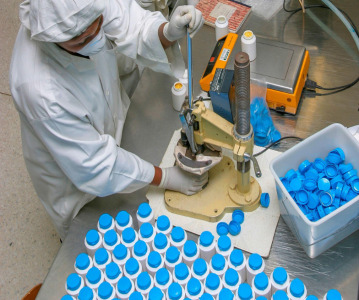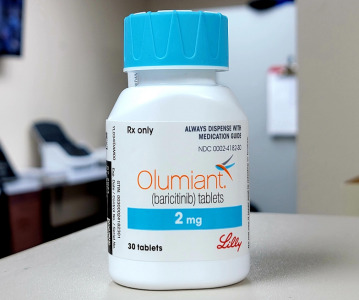US Pharma Outlook: Ten Trends to Look Out For in 2020

With CPHI North America fast approaching, we asked several industry experts what they see as the main trends emerging across the US pharma supply chain this year.
As we embark on a new decade, there has never been a brighter spotlight shining on the US pharmaceutical supply chain as the environment around it changes.
A much more diverse range of product types with shorter lifecycles has placed different demands on this crucial conduit between the research lab and the marketplace, as has an aging patient population. And tougher regulatory scrutiny with a keen emphasis on quality issues, particularly in active pharmaceutical ingredient (API) manufacturing, will continue to play a key role in shaping future efficiencies.
Greater efficiency in terms of process and cost will require collaboration between all the various stakeholders responsible for managing manufacturing and distribution functions and the healthcare services that act as the end-patient touchpoint.
The industry does have an exciting new toolbox to play with as it gears up to meet the challenges of speeding up product lifecycles, managing risk and fully utilizing the swathes of patient data which are becoming ever more important.
New disruptive technologies have the potential to revolutionize pretty much every link in the supply chain, but the challenge remains of deciding on which of these to focus to achieve the best outcomes.
Artificial intelligence and machine learning have undoubtedly come to the fore but there are many challenges around how these cutting-edge solutions can best utilize the vast amounts of patient data.
With CPHI North America fast approaching, we asked several industry experts what they see as the main trends emerging across the US pharma supply chain this year...
1. Excipient innovations to deliver more function at lower cost
Dago Caceres, Global Strategic Marketing Director, DuPont Nutrition & Biosciences
Dago Caceres, Global Strategic Marketing Director, at DuPont Nutrition & Biosciences believes that an aging global population—with a growing pill burden—will continue to drive good underlying demand growth for excipient manufacturers, who will have opportunities to provide additional value with innovative products that improve solubility and patient compliance.
“The increase in the use of generics and evolution in techniques used to produce excipients are driving this growth,” he says. “Twenty years ago, maybe one in ten prescriptions was a generic product but if you fast-forward to today, nine out of ten prescriptions in the US are filled with generics. This trend is also prevalent in Latin America, India, and Germany. Even Japan, the last country that was still buying a lot of branded innovative material, now has a very strong policy in place to really push generics.”
However, he admits the excipient category is not immune to cost pressure as universal healthcare initiatives squeeze profits along the entire pharmaceutical supply chain: “The challenge for the pharmaceutical industry and for excipient suppliers is that output is going to be higher but the costs need to be equal or lower and at the same or better quality.”
With people living longer—well into their 80s and 90s – and not dying of the common diseases they once did, innovation in excipient manufacturing continues to focus on helping drug makers meet the needs of this aging population and the increasing prevalence of lifestyle diseases.
“Drug development used to focus on the very large therapeutic classes—hypertension, diabetes, even antibiotics but that is no longer the case,” Caceres says. “Now we’re talking about much more complex issues and more orphan indications, which require pharma companies to develop more sophisticated APIs – that’s much more challenging from a solubility standpoint.”
2. Continuous processing to transform pharmaceutical manufacturing
Paul J. Tramo, President, Sentinel Process Systems
Within the manufacturing sector, momentum is switching from batch to continuous processes as more pharmaceutical companies begin dedicating internal resources to continuous processes and ‘flow chemistry’, says Paul J. Tramo, president at Sentinel Process Systems.
He adds that new technologies are allowing users to reduce raw material use, automate process development studies and calibration, and help with micro-dosing and containment.
The consensus of the industry is that continuous processing is the long-term future and is only held up by the bandwidth necessary for companies to target and convert existing process to continuous operation.
“In some instances, companies are skipping the batch step altogether and are developing new chemistry and molecules only in flow systems,” says Tramo. “While this progress is admirable, it is still relatively slow compared to developments in other new technologies like electronics, due to the installed base of batch equipment and companies’ inherent reluctance to make wholesale changes. However, this reluctance is yielding to the recognition that the first principles engineering design favors flow chemistry.”
He argues that the “unassailable reason” that flow chemistry is so attractive is that the heat removal for exothermic reactions is orders of magnitude better in flow systems than batch—allowing for these high energy reactions to be run at room temperature and at higher pressure, thus decreasing reaction times.
“In addition, this change opens up venues for new chemistries and reaction paths to make new and existing products that didn’t exist in the recent past,” he says. “Also, the low volumes of materials used in flow chemistry—an order of magnitude less as compared with similar batch ones—results in enhanced safety, higher raw material selectivity and hence better economics due to the shrinking volume of chemicals committed at any point in a process.”
3. Breaking through the controlled substance stigma to deliver new treatment paradigms
Jessica Rousset, COO, CURE Pharmaceutical
With the first FDA-approved cannabis extract (Epidiolex) emerging from the stigma of recreational cannabis, the pharmaceutical industry has taken notice of the potential therapeutic uses of scheduled drugs with no currently accepted medical use, says Jessica Rousset, COO at CURE Pharmaceutical.
“Last year, the FDA fast-tracked studies evaluating the safety and effectiveness of MDMA to treat PTSD and psilocybin for the treatment of depression,” she says, adding that compounds such as ibogaine and its prodrug, noribogaine, show promise in the treatment of alcoholism, cocaine and opioid addiction.
Working with the FDA, Risk Evaluation and Mitigation Strategies (REMS) can be established to mitigate risks of abuse and diversion without limiting their access to patients who have often exhausted all approved treatment options.
Rousset argues that as these ‘alternative’ treatment strategies go mainstream, manufacturers will be looking to leverage alternative formulations to deter abuse, widen the therapeutic index, accelerate onset and ensure precise dosing: “For example, Spravato (Esketamine) was approved for treatment resistant depression as a nasal spray for rapid delivery to the CNS without undergoing first pass metabolism.”
She says this avoidance of pills being digested is important because liver damage has already occurred in a significant subset of patients taking Epidiolex.
“Next generation formulations, such as buccal and sublingual dose forms, can offer meaningful improvements to patients taking these first in class therapies,” she concludes.
4. Advances in serialization to step up supply chain security
Adam Schroeder, Director of Business Development, ALMAC Group
Serialization remains a dominant trend for the packaging industry as manufacturers and packagers work to meet the timelines of the US FDA’s Drug Supply Chain Security Act (DSCSA) of 2013, according to Adam Schroeder, Director of Business Development at ALMAC Group.
The DSCSA established requirements to facilitate the tracing of prescription drug products through the pharmaceutical supply distribution chain. The FDA mandated that manufacturers and repackagers place a unique product identifier on certain prescription drug packages.
“Wholesalers and dispensers are restricted to buying and selling drugs with such identifiers, beginning in 2019 and 2020, respectively,” Schroeder says, explaining that the law is meant to enhance the FDA’s ability to help protect consumers from exposure to drugs that may be counterfeit, stolen, contaminated, or otherwise harmful.
“The European Union had a similar law take effect in February 2019, and though the industry overall has struggled with what the standards of serialization should be, companies should take a really robust approach in terms of the validation and being in complete compliance,” he adds. “I see more challenges on the horizon as serialization becomes the industry norm. The data management part of it will likely be the next thing regulatory agencies look at. It hasn’t been a full focus in the past, but in the years to come, regulators will be looking at software validation, into your line, into your equipment, and into network servers.”
5. Smarter use of digital solutions can speed up clinical trials
Marc Foster, Co-founder and Ex-COO, Transparency Life Sciences
Marc Foster, co-founder and ex-COO of Transparency Life Sciences is of the opinion that amid a proliferation of smaller drug companies without Big Pharma budgets seeking the competitive advantage of being early to market, solutions such as crowdsourced clinical trial protocols, virtual digital patient data collection, and broad-based services from smaller, nimbler partners are helping them get to market quicker and at lower cost.
“A major downside of the current clinical trial model is the high cost of collecting data at a traditional site such as a hospital or clinic,” he says. “It’s extremely expensive; you’re loading the per-patient cost of a trial with the high fixed costs of an institution. This is particularly true in therapeutic areas such as central nervous system (CNS), autoimmune disorders, chronic cancers, and many rare diseases.”
He believes that much of this data can actually be collected using mobile health solutions and telemedicine: “Study data, such as blood pressure, weight, and pulse rate, can be collected in a patient’s home or workplace with digital technologies, specifically telemedicine devices and virtual video-visit technology—eliminating or reducing the need for site visits.”
6. Using AI to create better clinical trials
Charles K. Fisher, Founder and CEO, Unlearn.AI
According to Charles K. Fisher, Founder and CEO, at Unlearn.AI, in-human clinical trials are time-consuming, expensive, and risky and as a result, there is tremendous interest in adopting technologies — such as artificial intelligence (AI) — that can make clinical trials faster and more efficient.
He says that examples include using AI to recruit patients faster, to selectively recruit patients who are likely to respond to a new therapy, or to leverage historical and/or real-world data to run trials in which fewer patients are randomized to placebo control arms.
However, he argues that making clinical trials more efficient is not good enough: “The patients who volunteer for trials, and others waiting for breakthrough therapies, deserve more. In addition to gains in efficiency, there is an opportunity to leverage AI to make evidence generated by trials more reliable and less biased.”
He gives the example of AI being used to integrate knowledge about disease progression across diverse patient populations to better understand how a new therapy will benefit patients outside of the controlled environment of a trial.
“Achieving these goals will require close collaboration between technology companies, trial sponsors, regulators, and patient advocates,” he says. “If we do it correctly, AI will help create a future with clinical trials that are both more efficient and that lead to better outcomes for patients.”
7. CDMOs to make the most of finished dosage formulation opportunities
Lee Karras, Former CEO, Halo Pharma
Efforts to ease patient burden with multi-API products and the increasing number of candidate products with low bioavailability are creating opportunities for contract manufacturing and development organizations (CDMOs) to create value with innovative, but complex, finished dosage formulations, says Lee Karras, former CEO, Halo Pharma.
“Providing patients with solutions that allow them to dose less frequently and reduce complexity are a major selling point,” he continues. “The emergence of smaller-volume products is creating practical challenges, however, for process design and scale-up. As we see fewer and fewer blockbusters—on the small molecule side at least—drugs are being repurposed or even combined which requires further development, thus benefitting CDMOs.”
He is of the view that multi-API products allow pharma companies to better address patient needs while extending some market life due to additional IP protection: “We’ve already seen this in anti-infectives (HIV) -- patients once had to take 10+ pills a day, now it’s one to three. I think we will see this trend evolve into other indications, including cardiac, CNS and pain. There are also opportunities in combining opioids and opioid antagonists in one dose to treat pain while potentially mitigating the risk of opioid addiction.”
8. Control of potential carcinogenic impurities – a collaborative effort
Rajesh Sadanandan, Region Head – North America & Europe API, Dr Reddy’s Laboratories
One key incident that has rocked the API world over the last two years has been the detection of nitrosamine impurities, according to Rajesh Sadanandan, Region Head – North America & Europe API, Dr Reddy’s Laboratories.
This potentially carcinogenic ingredient was first found in sartan blood pressure medicines and later in ranitidine samples.
"We’ve seen that this resulted in numerous recalls of such medicines from pharma companies globally and required all manufacturers to diligently review their manufacturing processes and analytical methods,” says Sadanandan.
Health authorities have reacted strongly: the US Food and Drug Administration (FDA) has asked manufacturers of ranitidine (Zantac) and nizatidine (common heartburn medicines) to test for NDMA impurities and send samples to the FDA.
The FDA is also conducting ongoing investigations into presence of nitrosamine in other drug products including metformin.
Sadanandan explains that this issue presents a different set of challenges and problems to the pharmaceutical supply chain: “These new reviews will be a continuous process and will have a massive impact on raw material sourcing and processing conditions. Tighter controls of key starting materials will further add to the complexity and the volume of key data required by API manufacturers from starting material vendors.”
He is of the opinion that 2020 will show how companies are prepared to keep up with these new regulations and challenges: “It’s a collaborative effort of starting material, API and finished formulation manufacturers. It might be tough, but also provides a competitive edge for those manufacturers who already pro-actively have assessed their processes including starting material manufacturing.”
9. CDMOs need to adapt to evolving biologics landscape
Anil Kane, Global Head of Scientific and Technical Affairs, Thermo Fisher Scientific
The big long-term evolving trend in pharma over the last decade has been the move away from traditional small molecule drugs towards biotech-centered strategies, according to Anil Kane, Global Head of Scientific and Technical Affairs, Thermo Fisher Scientific.“
While the traditional synthetic small molecule is still a popular strategy, four out of 10 new drugs in the pipeline are biologicals,” he adds.
The increasing investment by the pharmaceutical industry in their R&D pipeline of drugs in the category of high potent APIs, biologics and cell and gene therapy demands expertise, experience and the right infrastructure within CDMOs to progress the molecules from clinical development to approval, says Kane.
He believes pharma companies will continue to outsource their drug candidates to experienced and reputable CDMOs with development and manufacturing capacity: “Sponsors are also seeking CDMOs as a one-stop shop from API development (small or large molecule), through clinical support and commercial capacity to bring speed and cost efficiencies including supply chain benefits.”
10. Tech companies learning that outcomes data leads to adoption
Aurelio Arias, Senior Consultant - European Thought Leadership, IQVIA
Aurelio Arias, Senior Consultant - European Thought Leadership, IQVIA argues that tech companies will continue to penetrate the healthcare sector but will have to quickly realize the importance of firm clinical evidence.
“A large proportion of tech companies have entered healthcare and found it challenging to navigate the numerous stakeholders in a sector where it is not always clear who has the decision-making power to adopt their technologies,” he says. “Start-ups have come to realize that a patient-centric solution, although hugely important, may be of little use if the lack of robust clinical evidence or enhanced efficiency prevents adoption by prescribers and payers.”
He adds that when elegant solutions do present themselves, it does not guarantee an easy journey if it requires the heavily regulated healthcare system to adapt rapidly.
Arias believes that the primary focus of a digital product will shift from simply creating a commercially attractive solution to one that generates robust evidence as start-ups realize that it is outcomes data that leads to greatest adoption.
“Healthcare systems are becoming more flexible and experimenting with existing workflows, especially when efficiency is increased,” he says. “Radiology is an example where machine learning software is changing the way radiologists perform their work. Other departments will open up when confronted by actionable insights.”
Contribution to this article
A big thank you to all who contributed their expertise and time to this article.
Eager to learn more? Join us at CPHI North America in Philadelphia, September 9-11, 2020, to meet with more than 500 exhibitors and 5000+ visitors from across the Pharma supply chain, and to attend our free on-site conference. With more than 30 hours of content from thought leaders across drug development, delivery and manufacturing, don’t miss the opportunity to update your knowledge on key industry trends and developments.
Are there any other trends you feel urgently require the industry’s attention? If there is an exciting trend or development you think we should focus on for this year, please get in touch - email Gareth Carpenter at [email protected]
Related News
-
News Women in Pharma: Moving beyond discussions and into best practice at CPHI Milan
In this second CPHI Milan special of our monthly series, we cover the key takeaways from the Diversity & Wellbeing track held on October 10, 2024. -
News AstraZeneca invests in AI collaboration for cancer drug trials
The British-Swedish pharmaceutical giant is partnering with biotechnology firm Immunai Inc to increase the efficiency of some cancer drug trials. -
News Ozempic and Wegovy prices questioned as Novo Nordisk faces US Senate hearing
The CEO of Novo Nordisk was grilled during a US Senate committee hearing on September 24, 2024, in which the exorbitant prices of the Danish company’s blockbuster drugs Ozempic and Wegovy were called into question. -
News The BIOSECURE Act: implications for the pharma supply chain
On September 9, 2024, the US House of Representatives voted to pass the bill titled the BIOSECURE Act (the Act), which lists several Chinese companies in the pharmaceutical supply chain. The Act will prohibit American companies from contracting or doin... -
News On Track at CPHI Milan: Thermo Fisher Scientific Track Sponsor interview
With CPHI Milan just around the corner, we sat down with some of the sponsors for this year’s conference tracks to discuss the most pressing topics in pharma. -
News CPHI Milan Speaker Spotlight: Pharma Manufacturing and Localisation in Africa
In the run-up to CPHI Milan, we sit down with some of the experts and thought-leaders speaking at this year’s conferences. -
News US BIOSECURE Act passed by US House of Representatives
The controversial act, which has already impacted several foreign companies operating in the US, was passed by the House of Representatives on September 9, 2024. It is now headed for the US Senate before it can be signed into law by President Joe Biden... -
News Eli Lilly licenses rheumatoid arthritis manufacturing in Africa
American pharmaceutical company Eli Lilly has signed a partnership with Egyptian organisation Eva Pharma to localise manufacturing of rheumatoid arthritis treatments in Africa.
Position your company at the heart of the global Pharma industry with a CPHI Online membership
-
Your products and solutions visible to thousands of visitors within the largest Pharma marketplace
-
Generate high-quality, engaged leads for your business, all year round
-
Promote your business as the industry’s thought-leader by hosting your reports, brochures and videos within your profile
-
Your company’s profile boosted at all participating CPHI events
-
An easy-to-use platform with a detailed dashboard showing your leads and performance

.png)





